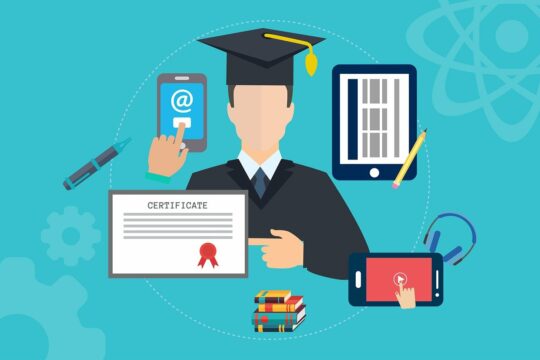“Technology will never replace great teachers, but in the hands of great teachers, it’s transformational.” – George Couros.
Be it writing, thinking, or working, the first thing these days that comes to our mind is the pandemic and its impact. COVID-19 has reshaped, redefined, and accelerated the adoption of technology across various sectors.
Along with everything else, the pace at which EdTech initiatives have shaped up for better is commendable; the reason could be the advancement of technology, flexible models, or the FOMO effect. Due to COVID-19, overnight, everything switched to remote – remote working, remote celebration, remote learning, and more.
Others may have witnessed a couple of challenges, but EdTech has seen consistent and prominent growth in acceptance and adaptation. The pace hasn’t slowed down even a bit; the same is anticipated to grow exponentially in coverage and relevancy. EdTech, for numerous apparent reasons, is here to stay forever.
As per the Holon IQ report, global EdTech started the last decade with US$500 million of Venture Capital invested in 2010 and finished 32x higher at US$16.1 billion in 2020, nearly 2x the previous investment record in 2018.
Technology can become the “wings” that will allow the educational world to fly farther and faster than ever before—if we will allow it
Another report by Venture Intelligence states that the EdTech investments in India made a fourfold jump in 2020, from US$409 million in the previous year, as the pandemic pushed users to online education.
The justified rise is visible for the most obvious reasons. The advanced solution using developing technologies like Artificial intelligence (AI) and robotics, Virtual Reality (VR), Augmented Reality (AR), Mixed Reality (MR), and other forms are creating a platform to suffice the comprehensive need of the system, enabling a shift from conventional to experiential methods of smart learning.
Organizations like EduBridge India, eLitmus, Collegedekho, Pagalguy, etc., have already shifted focus from traditional learning processes to technology-driven systems to bridge the existing gap and match the future’s needs. Similarly, even individuals have walked the extra mile to accept the fast-paced demands, changing uncertain times and adapting to them. For both, EdTech has emerged as the most relevant enabler. We would all accept that “Technology can become the “wings” that will allow the educational world to fly farther and faster than ever before—if we will allow it.”
There are numerous benefits and highlights of EdTech that can’t be disregarded, as compared to the traditional ways and other approaches. A few are:
- Customizable: It can be tweaked as per the need. It is adaptable to any industry and market need, with no constraint of clinging to the traditional content. The democratization of content is the real need of time, and EdTech is enabling that.
- Self-paced: We have stopped talking about work-life balance as we can’t find any. In a life full of uncertainties and surprises, employees will appreciate a model that allows them to learn at their own pace, when they can. Learn from anywhere, anytime.
- Engaged learning: Gamification of learning techniques has helped the user better understand, making it more interactive and engaging. It can help in achieving more learning retention.
- Real-time: It’s adaptable; constant innovation helps to keep pace with changing trends. The most relevant up-to-date features and content gets upgraded as and when needed making learning more effective and appropriate.
- Integration: We all accept that it’s just a tool that has integrated well with existing learning methods, processes, and people to empower the same. The core and foundation are the same as before; the mode has amplified because of technology. EdTech has brought out the best-integrated combination of education and technology.
- User-friendly: Easily accessible and easy to use, the first two criteria that define whether an employee will hold on to the program or not. When these two aspects are taken care of, it becomes a go-to window to learn and evolve naturally.
- Independent system: Time is the biggest constraint, and so is the availability of all concerned at a particular time. This self-sustaining system eases out the concern of dependency and interdependency. The method in itself is self-sufficient in self-service mode.
- Data-Driven: In this fast-moving world, it generally becomes next to impossible to know the market and keep up to the changes. A system that uses analytics to redefine and reform comes in handy for organizational development.
- Personalized: These initiatives provide highly personalized learning experiences based on learning patterns and behavior. One size fits all; it doesn’t hold any relevance now. Learners seek freedom to explore, mix, plan and experiment as per their interest and understanding.
The shelf life of skills has become insanely short, which in turn is exponentially increasing the skill gap. There is no better tool than technology to create a shield that enables overall development and advancement to keep up with the demand of market, transformations, innovations, and evolutions. EdTech has evolved and revolutionized the way of work. As rightly said, “what got you here won’t get you there” holds so much relevance in today’s competitive time. And to coexist and excel, employees and employers will have to continuously identify and improve upon existing skills by changing and adapting to the new as and when required. Like John Dewey said,” If we teach today as we thought yesterday, we rob our children (employees) of tomorrow.”
The shelf life of skills has become insanely short, which in turn is exponentially increasing the skill gap. There is no better tool than technology to create a shield that enables overall development and advancement to keep up with the demand of market, transformations, innovations, and evolutions
Education has always been the core and foundation of any role or profile, and technology has empowered and enabled Organizations and people both to an unimaginable level- a supreme level. A path that can be self-created, adapted, and achieved to design a better today and tomorrow.
EdTech can do magic but not alone. Company culture has to support the need and initiative. In addition to the organization’s culture, there could be other challenges like financial constraints, non-acceptance to adaptation, lack of technical know-how, shallow learning models, and scattered strategies. To achieve the desired goal, organizations will have to go beyond the conventional approach and enable learning through technology, and that’s doable, but are we giving enough space and time to our existing employees to invest sufficiently in learning. That’s a bigger question to ask and address. If we can integrate learning and work well, EdTech can serve as a game-changer. As Laver Burton rightly said, “If we marry educational technology with quality, enriching content, that’s a circle of win.”
The current stage is conceivably the most compelling and disruptive stage of EdTech. It will play a crucial part in bridging the supply gap and redesign the future of learning. EdTech, moving forward, will only get bigger and better.
It has become more than essential for organizations to upskill the workforce to win the game in most uncertain times, and to achieve that, technology should be the carrier.
Today, we don’t need EdTech; we have to live EdTech. Embrace it well.

Dr. Ankita Singh
Guest contributor Dr. Ankita Singh is the Senior Vice President & Global Head of HR, IT, Travel & Admin CIGNEX. Singh holds a Ph.D. in Management and is a Gold Medalist in BBA as well as MBA. Recently, she has been awarded amongst Forbes India’s Top 100 Great People Manager by the study conducted by GMI India. Any opinions expressed in this article are strictly that of the author.












